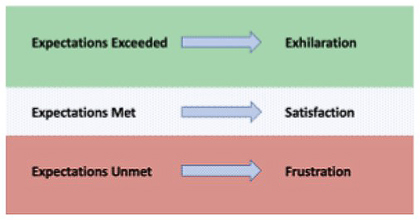-
GAPS: Four Steps to Being a Better Leader
April 2, 2021
Have an opinion? Add your comment below. -
As a leader, you’ve experienced gaps. We all have – those gaps between what our expectations are and what reality is, like the time when a team member was upset that he had not been consulted about a logo redesign. Even though his role in the organization had absolutely no direct connection to marketing, he was frustrated by the gap between his expectation that he’d be a part of the effort and the reality that he was not even consulted. Gaps can, of course, be positive, too. I was exhilarated (yes, exhilarated!) when a team leader brought a project finale to me that had significantly more depth and more creativity than I had expected. It turns out my expectations paled in comparison to the eventual outcome, and I was thrilled.
Gaps are common and to be expected, but to the degree you feel exhilaration or frustration depends on how wide the gap is between reality and your expectations. This is true in life and leadership. Why is this important to understand as a leader? Because it can point to how well you communicate or even what kind of team member you have. And, the truth is that leaders do not always have realistic expectations, nor do they always communicate as clearly as they think they do.

Here are four steps a wise leader takes when feeling exhilarated or frustrated in any given situation:
(1) Have SMART Expectations
Ask: Were the expectations I set, in fact, reasonable? If others are consistently exceeding expectations, perhaps the bar can be raised because I’m aiming too low. If others are too often falling short of expectations and I am frustrated, that’s a good indication I need to revisit how I go about setting expectations. The results you see are feedback you can use to improve communication and goal-setting. If you are unfamiliar with the acronym SMART, here is a <4 minute quick reference.
(2) Strive for Clarity
Ask: Did I clearly communicate the expectations? In a breakup, it is the classic line, “It’s not you, it’s me.” This might hold true for a gap you’re facing. You and I could be contributing to the problem. Ambiguity is destructive to those we lead, so particularly in situations where expectations were left unmet, you and I have to look first at ourselves to see if we played a part in that. Simple communication is not as simple as we might think. (This scene from Monty Python is a great example!)
(3) Understand Context
Ask: Is this an isolated homerun or failure? Or, is this a continuation of a pattern? Apophenia is seeing patterns where others don’t (like seeing specific shapes in the clouds). If the team member has had a tremendous success but it is rather uncommon, then what a perfect time for celebration. And, if the team member has had a rare moment falling short of expectations, then what a perfect time for follow up coaching. If this is not an isolated occurrence, but rather a pattern of behavior – and we’ve already thought through #1 and #2 above, then it is time to ask the fourth question.
(4) Define the Trend
Ask: What does this pattern say about the future for this team member? If you have someone who continues to exceed expectations time after time, the wise leader will find ways to grow that individual, provide opportunities for advancement and new challenges, or face the prospect that s/he will ultimately leave for opportunities and challenges elsewhere. And, of course, if someone has a pattern of frustrating you because of unmet expectations, well… you know what should happen there.
Taking advantage of what we can learn from the gaps between reality and our expectations will help grow us as leaders. We can never eliminate them, nor do we want to eliminate the gaps certainly on the positive side of things, but the question is what can you and I learn and apply from those gaps. Great leaders set proper expectations and communicate well.
Proverbs 14:8a, “The wisdom of the prudent is to give thought to their ways….”
-
-

